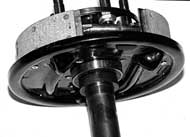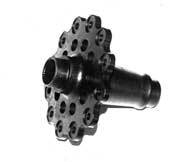 When
setting up ring and pinions, you’ll often hear the term "balanced pattern."
What does it mean? According to Peter Wille, it’s when the "wipe" of the
pinion gear against the ring gear is equal on both sides of the ring gear tooth. Having a
balanced pattern simply means improved gear life, but a side benefit is less noise. In
addition, a proper pattern will look like a relatively long, smooth oval, and it should
slightly favor the toe or the inside of the ring gear. Why should the pattern favor the
toe side of the ring gear? In a typical hi-po situation, the pattern will
"stretch" under loads (which can be quite high, especially if there is some
power under the hood and some hook at the back end of the car). In essence, this pattern
reaches from one end of the gear tooth to the other (from the toe to the heel). If the
pattern favored the "heel" or the outside portion of the ring gear, then
there’s a good chance that the "pattern" or true contact area woulds go
right off the end of the ring gear. By the way, a pattern that favors the toe or inside of
the gear tooth will be somewhat noisier than a heel pattern, but in this case that is a
small price to pay for reliability.
When
setting up ring and pinions, you’ll often hear the term "balanced pattern."
What does it mean? According to Peter Wille, it’s when the "wipe" of the
pinion gear against the ring gear is equal on both sides of the ring gear tooth. Having a
balanced pattern simply means improved gear life, but a side benefit is less noise. In
addition, a proper pattern will look like a relatively long, smooth oval, and it should
slightly favor the toe or the inside of the ring gear. Why should the pattern favor the
toe side of the ring gear? In a typical hi-po situation, the pattern will
"stretch" under loads (which can be quite high, especially if there is some
power under the hood and some hook at the back end of the car). In essence, this pattern
reaches from one end of the gear tooth to the other (from the toe to the heel). If the
pattern favored the "heel" or the outside portion of the ring gear, then
there’s a good chance that the "pattern" or true contact area woulds go
right off the end of the ring gear. By the way, a pattern that favors the toe or inside of
the gear tooth will be somewhat noisier than a heel pattern, but in this case that is a
small price to pay for reliability.





